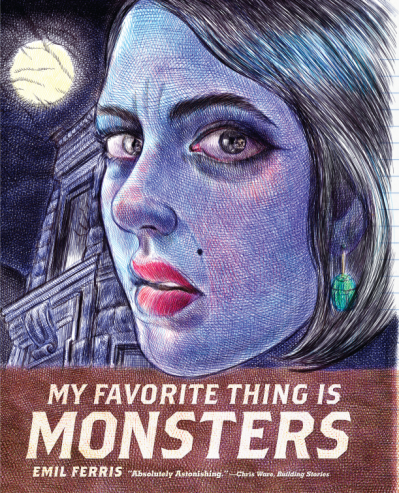Thursday Comics Hangover: My favorite thing is My Favorite Thing Is Monsters

You've likely read something in the last month about Emil Ferris's stellar graphic novel My Favorite Thing Is Monsters, which was just published by Fantagraphics Books. NPR's John Powers explains the story of how Ferris came to create the book:
She was a 40-year-old single mom who supported herself doing illustrations when she was bitten by a mosquito, she contracted West Nile virus, became paralyzed from the waist down, and lost the use of her drawing hand. Fighting chronic pain, she taught herself to draw again, then reinvented herself as a graphic novelist, spending six long years creating what's clearly an emotional autobiography.
It's a remarkable story, and Monsters is a remarkable debut. It tells the story of Karen Reyes, a monster-obsessed young woman in 1960s Chicago who investigates the murder of her upstairs neighbor, a Holocaust survivor named Anka. Karen imagines herself as a monster — a human eternally transitioning to a werewolf.
It will take you a while to get into the plot, though, because the art is unbelievably, distractingly good. Ferris is a world-class illustrator. Using what appears to be colored pencils on lined three-ring binder paper, Ferris replicates classic works of art and dreams up pulpy sci-fi/fantasy/horror magazine covers and renders startling portraits of characters. Those portraits are the most astounding part of the book. There is life behind these faces. These eyes are more than ink on paper: they're judging you, imploring you, seeing you.
You've never seen comics like this. The art of Monsters relies on a blend of comics techniques: some pages use the traditional panels-and-word-balloons of American comics, but many of the layouts blend words and pictures in new ways — dreamy montages with narration spooling out in margins, blocks of brief essays interpolated in full-page illustrations, double-page spreads of fever-dream faces appearing in the wood paneling of an ugly apartment.
Monsters feels to me like a once-in-a-generation debut — a vision so clear and original that it will change the course of cartooning. Ferris's book lands with the force of a Chris Ware or a Robert Crumb. Newcomers to comics will be consciously and unconsciously emulating her style and storytelling techniques for decades to come.